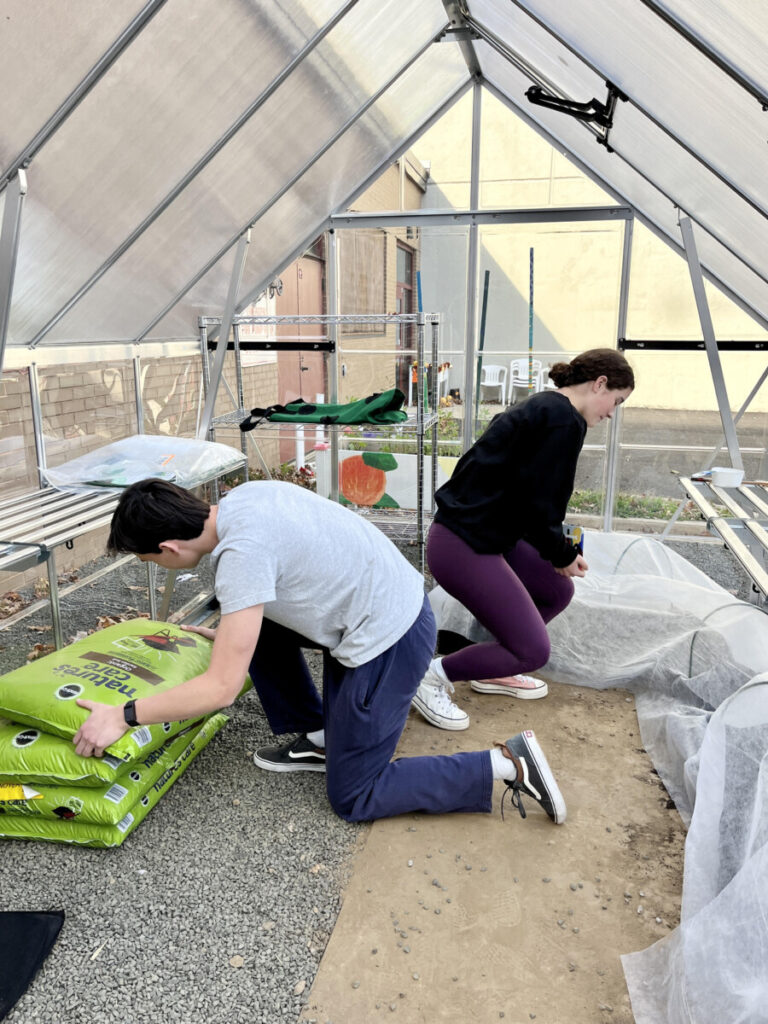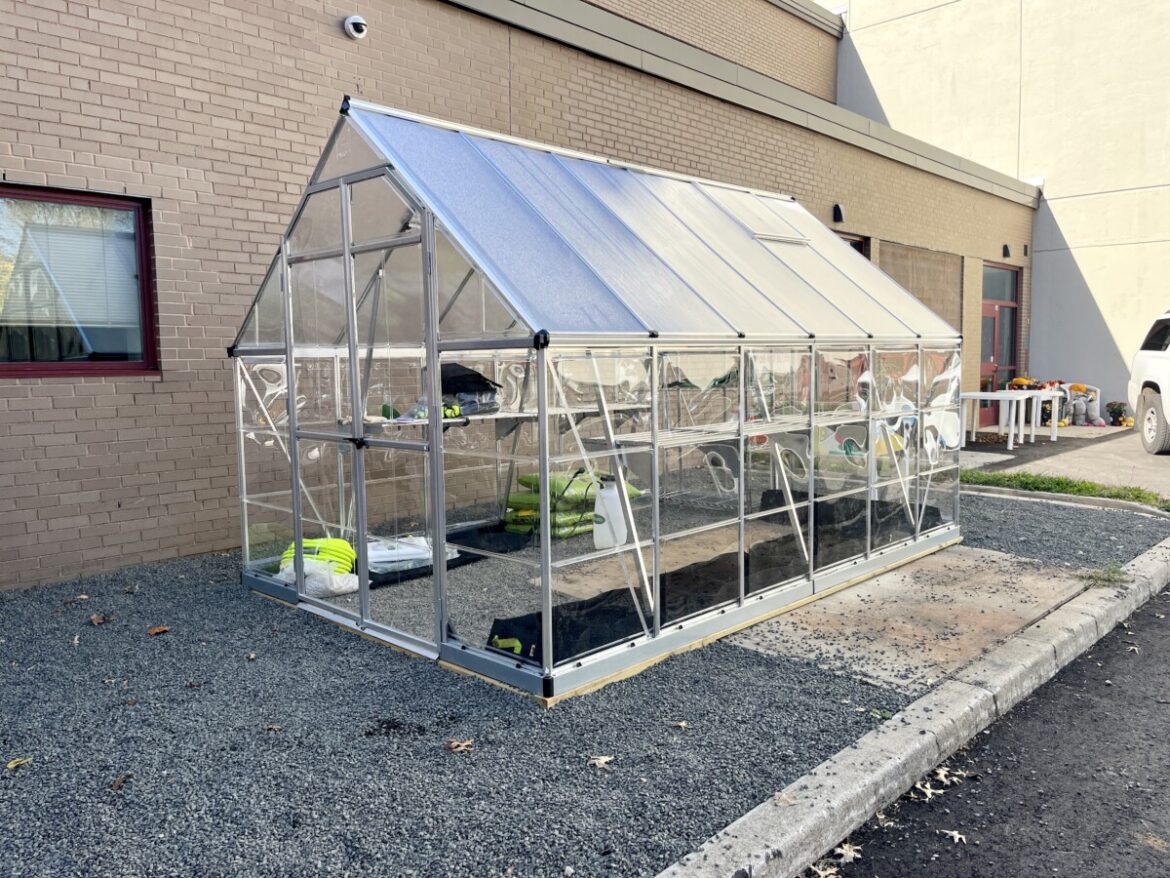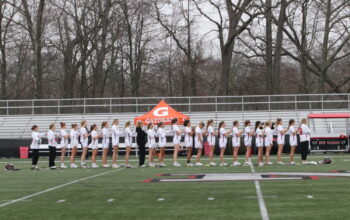Ava Fonss, Editor-in-Chief
@afonsscourant
Although the start of the winter season is associated with bare trees and the loss of colorful fall foliage, at the new greenhouse—installed directly outside of the Foods and Nutrition classroom—sprouting carrots, spinach, and scallions are bringing vibrance to the school community through an upcoming winter harvest. With the help of the special education department, new vegetables will be grown in the greenhouse throughout the year for use in culinary courses.
For Career and Technical Education (CTE) Teacher Kelly Zilly, who initiated the project, the greenhouse is a way to both enhance the culinary courses she teaches in the CTE department and pursue her own interests. “I’ve wanted a greenhouse at the school for a while,” Ms. Zilly said. “Understanding where food comes from is something that’s super relevant to the culinary courses, but also something that I personally have a passion for.”
The inspiration to create the greenhouse came from Ms. Zilly’s experience with learning about food and sustainability. “Last year, I had the opportunity to take plant-based cooking classes at the Culinary Institute of America so I could get more background knowledge on working with plants,” she said. “I’ve also been involved with Yellow Farmhouse, an educational farm in Stonington, Connecticut, and they do a lot with teaching about sustainability and farm-to-table.”
The greenhouse is currently about twelve by eighteen feet and can be accessed through the Foods and Nutrition classroom. “The current size is perfect for what we’re doing right now and allows us to grow a decent amount for the class,” Ms. Zilly said. “The location was something we had to think about because there are so many other things going on around the school, and the greenhouse obviously needs a good amount of light, but the location we chose is easily accessible for students.”
Speech-Language Pathologist Melissa Mahon and Special Education Teacher Katey Paige, who both founded the Bouquet Buddies program—a service that allows students in the special education department to deliver flower arrangements to faculty members—decided to expand their program to involve their students in Ms. Zilly’s greenhouse project. “We try to involve our students in activities that develop skills that are functional in real life,” Ms. Mahon said.

According to Ms. Zilly, students involved in the Bouquet Buddies program will be helping in the maintenance of the greenhouse throughout the year. “Although this was something that I had originally been developing for the Career and Technical Education department, the Buddies group and special education team work right next door and I collaborate with them a lot on different projects, so we decided that this was something that we wanted to work on together,” she said.
Ms. Zilly has been working with the Buddies group to track student involvement. “The students have been doing a lot of work in their classes learning about what a greenhouse is, what it’s used for, and how to maintain it, but I have been working with them to communicate about their daily tasks,” she said. “I have a chart where they write down who waters the plants each day, and I am also getting a thermometer out there so that they can track temperatures throughout the day.”
As the plants begin to sprout, Ms. Zilly hopes to incorporate other tasks and activities for students to help monitor the progress of the greenhouse. “I’ve been teaching them about how important things like watering and tracking temperatures are, as well as how we have to generally maintain things out there,” she said. “Later on, they are going to start journaling about how things are growing.”
Ms. Paige believes that involvement with the greenhouse will allow her students to develop the skills they may need to live more independent lives. “For them, this is science—it’s something they’re learning but it’s also something they’re going to need to know how to do after high school when possibly living on their own,” she said. “We used to have students who would water the plants at the Lapham Center, so this greenhouse could help to sharpen their day-to-day skills but it could also turn into a job for them someday.”
Beyond creating a routine for students, involvement in the greenhouse also helps with developing communication skills. “They have to communicate with us as their teachers, but also with Ms. Zilly to coordinate their jobs and deal with real-life problem solving,” Ms. Mahon said. “They work on vocational skills like signing in and signing out, making sure the sprayers are full, following directions, and learning functional vocabulary. Problem solving and communication are skills that they will need in their everyday lives, and need to learn how to practice.”
For Ms. Zilly, the process of selecting different crops to grow in the greenhouse may also serve as a learning experience for the students in her culinary courses. “In the vegetable unit, I teach them about how different plants grow in different temperatures, climates, and areas,” she said. “We’re doing a winter harvest and chose plants based on the temperatures we have to deal with in Connecticut and the amount of space we have to work with. Right now we have scallions, spinach, and carrots, but in the springtime my students are going to have more conversations about what we can grow.”
According to Ms. Paige, the students in the Buddies group have enjoyed being involved in the greenhouse. “There are a few students who want to water the greenhouse every day, and they all seem to love working with Ms. Zilly,” she said. “I think having that connection is really beneficial. They really want to help out, and this helps get them outside of their regular routine and more involved in the school.”
Ms. Zilly also hopes to expand the capacity and use of the greenhouse in future years. “I think it would be great if we could get to the point where we could have a bigger greenhouse that we could grow more plants in and put an emphasis on more farm-to-table education,” she said. “This is our trial and error year so we can see what works and learn from that, but I plan for this to continue. Hopefully in a few years we can expand if everything goes well.”
In terms of expansion, Ms. Zilly is also looking to collaborate with other departments throughout the school. “I’ve gardened my whole life, but the true background knowledge of botany is within the science department,” she said. “It would be awesome to get them more involved, and I’m sure there are also ways to involve the arts. This greenhouse is for the school, so I would love for other people to be involved.”
Ms. Zilly also recognizes that involving the Buddies group with the greenhouse allows for consistency in terms of the students involved. “The classes in our CTE department are only semester courses whereas the Buddies group has the same group of students year-round, so having those kids involved has been great because they have a schedule that’s a little more maintainable for them to come and help out,” she said. “They’re in charge of watering the plants every day and doing daily tasks, so it’s been really nice to have that sense of consistency.”
Ms. Zilly hopes to facilitate collaboration between the Buddies group and the students in her CTE classes through the greenhouse. “It’s really important for students to get that structure set up, and I know that they’re really loving having daily tasks and getting involved with other teachers and classmates around the school,” she said. “I’m hoping to have some of the students in my culinary classes work with them once the vegetables are ready to harvest, but right now I think the greenhouse is great for collaboration and it’s teaching everybody some new and valuable life skills.”




